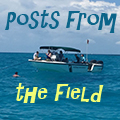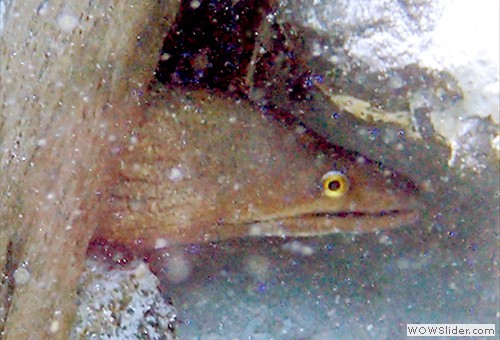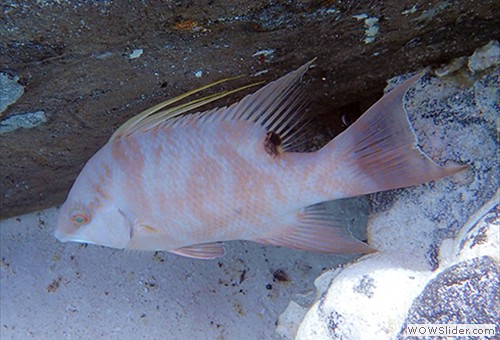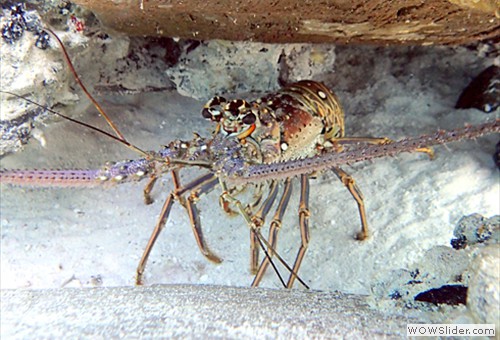Marine Life By Annie Wright 29 May 2016
While our main focus on the Pillar Dollar wreck site is the archaeology and human components, we are still surrounded by a variety of marine life. Maritime archaeologists can often tell archaeological sites from the ocean floor based upon the marine life growing on components of a site. Ships are made from materials not found naturally on the ocean floor, such as wood, iron, and fiberglass. These materials attract fish, corals, and other types of marine life, as holes, overhangs, and walls provide new habitat for these species to inhabit. Additionally, certain species, such as sponges, tend to congregate on iron. Sponges are often a “marker species” for shipwrecks that allow maritime archaeologists to identify them.
On the Pillar Dollar wreck, we have found a variety of coral species including fire coral (millepora alcicornis, although this is technically not a coral, as it is in the family Cnidaria, meaning it is more closely related to jellyfish than coral), golfball coral (flavia fragum), and smooth star coral (solenastrea bournoni).
Wrecks attract many fish species. So far, the fish we have seen include yellowtail snapper (Ocyurus chrysurus), Sargent Majors (Abudefduf saxatilis), several species of wrasses, and a particularly friendly hogfish, who has discovered that dredging on the site pulls up some tasty snacks for him.
Additionally, we have come across larger species, including the endangered Queen Conch (Strombus gigas). A skate, a cartilaginous creature that lives in the sand and closely resembles a ray, was found exploring our dredge spoil pile. Several southern stingrays (Dasyatis americana) have swum past us while working, and pods of bottlenose dolphins (Tursiops), have stopped by on several occasions to play in the wake of our dive boats.
A Caribbean spiny lobster was spotted hiding under the planking of the wreck. These lobsters spend their time hiding in crevices and under overhangs, and can often be seen by their long horns poking out through the cracks and entrances to their hiding spots. Spiny lobster is a popular fishery in south Florida, and since these lobsters often live on shipwrecks, lobster fishing can sometimes be a hazard to archaeological sites.
Dredging the site stirs up a significant amount of sand, and releases thousands of tiny organisms, as well as larger animals, such as worms, into the water. One friendly hogfish has discovered that if he spends his time close enough to the dredge, he can get first pick of the creature buffet.
An additional creature that has made his home in the wreck is a moray eel, who lives under Plank 5. Morays can potentially be dangerous, as they can easily bite a finger off if one gets too close. However, they are only defensive, not aggressive.
The ecosystem of the Florida Keys, combined with the protection of Biscayne National Park, creates an ideal habitat for marine life in an environment that they can grow in abundance. Shipwrecks, such as the Pillar Dollar wreck, provide additional habitat for coral reefs and their associated species to thrive. It is important to record the biological information of a site in the form of fish and coral counts, so that the site can be assessed for biological impact and for future use by biologists studying the ecology of shipwrecks.
Previous Next


 Moray eel
(Muraenidae) (photo by A. Ropp).
Moray eel
(Muraenidae) (photo by A. Ropp).  A
hogfish (Lachnolaimus maximus), searching for snacks on the site (photo by J. McKinnon 2016).
A
hogfish (Lachnolaimus maximus), searching for snacks on the site (photo by J. McKinnon 2016). Caribbean spiny lobster (Panulirus argus)
(photo by J. McKinnon 2016).
Caribbean spiny lobster (Panulirus argus)
(photo by J. McKinnon 2016).